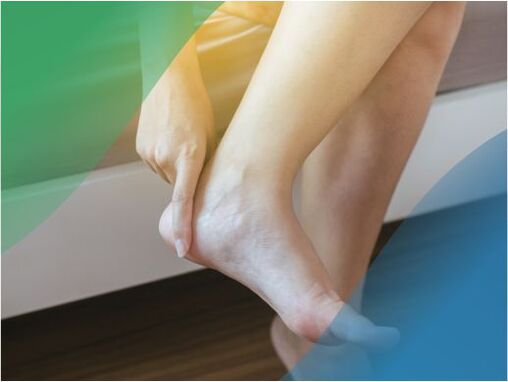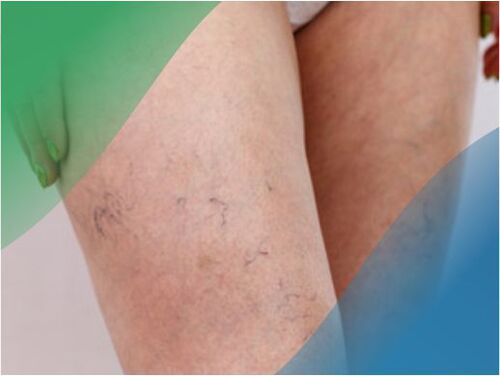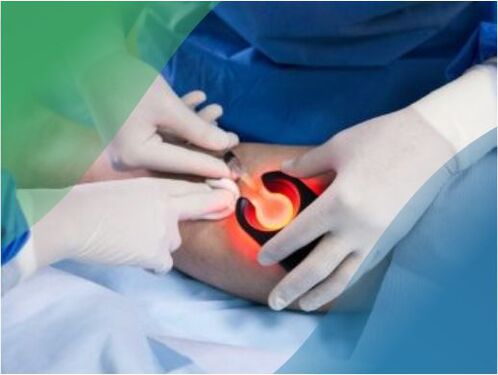
What do we mean when we hear the wordvaricose veins"? First, the ugly legs are purple-blue in color, covered with many tubers and a network of blood vessels visible through the skin. Many of us believe that varicose veins are a purely cosmetic pathology that does not require special treatment. There is an opinion that for many yearscan live with varicose veins that this disease does not progress and does not lead to serious consequences, only an external error remains. Unfortunately, this view is not only wrong but also dangerous.
To understand why varicose veins are dangerous, whether there is a way to avoid why the disease should be treated once it has appeared and, most importantly, how to do it, we have consulted a phlebologist for advice. We talk about the mechanisms of disease development, ways of prevention, lifestyle characteristics in the presence of this diagnosis, and modern correction methods.
What is varicose veins
,%20varicose%20vein%20(right).jpg)
Varicose veins have been a known disease for mankind since ancient Egypt. Archaeological excavations confirm the presence of pathology between the contemporaries of the pharaohs and the builders of the famous pyramids. Hippocrates and Avicenna, who were recognized as the best doctors of antiquity, were looking for ways to successfully treat varicose veins. What happens to varicose veins? Why does the disease occur?
In the human body, blood travels from the bottom up through the veins - from the tissues to the heart and lungs, and muscle contractions help. But because of the gravitational force that affects all aspects of human existence, fluid tends to fall down. The special keys in our veins do not allow you to do this. They open and close in the direction of blood flow to keep them away. Thus, under the "sensitive control" of the keys that exist in the veins, the blood gets to where it is needed.
But quite often for some reason the keys become dysfunctional, they don’t close completely, and the blood continues to flow through the veins. The blood vessels may not contain all the blood, they stretch and extend over the skin with tubers. The outer thin veins in the legs are most commonly affected in this way, and "varicose veins" occur.
Causes of the disease
There are several reasons for the development of varicose veins, all of which are well known in medicine.

- hereditary predisposition.Heredity is one of the most common causes of the disease. Scientists have identified a so-called "varicose veins gene" that is responsible for its appearance. Therefore, if your relatives have had any problems with their veins, you should see a phlebologist as soon as possible. After all, the disease can manifest itself at any age, even at a very young age. Varicose veins are insidious that the visible symptoms appear much later than the disease itself.
- Weakness of vessel walls and valve equipment.Many chronic diseases (pyelonephritis, rheumatism, hepatitis, cirrhosis, etc. ), hormonal changes and metabolic disorders, unhealthy lifestyle, lack of exercise, lower limb injuries, women taking hormonal contraceptives lead to this condition.
- Occupations related to long stays in a static situation(standing or sitting). Programmers, drivers, hairdressers, salespeople, carpenters, and many others are at risk for varicose veins.
- Pregnancy. Even if there is no inherited cause of the disease in the pregnant mother, the risk of "earning" the varicose vein during pregnancy increases significantly. Why does this happen? increases, thereby increasing pressure on the vessel walls and keyboard devices. The rapid weight gain of women during pregnancy puts unusually strong pressure on the legs and, accordingly, the veins.
- Overweight.In case of overweight, the deformation of the vessel wall occurs due to the high load, the pressure of the vascular system and the surrounding tissues increases. In case of overweight, blood pressure rises, it becomes difficult for blood to enter the heart, and venous congestion occurs.
- Gender and age.According to statistics, more than 70% of varicose veins occur in women of childbearing potential. However, cases of the disease are not uncommon in men, children and adolescents. Therefore, if any disturbing symptoms occur, a phlebologist should be consulted regardless of the patient's gender and age.
Symptoms of the disease
As mentioned above, in the early stages of the disease, it is disguised as asymptomatic or routine fatigue: after a day of work, the legs buzz and swell, but by morning or after a long rest, everything goes away. There may also be nocturnal cramps, itching and a burning sensation in the lower extremities, a feeling of heaviness in them. Such symptoms are usually not a cause for concern and are described as banal overtime. The early stages of varicose veins do not reduce a person’s physical activity, they do not force them to change their lifestyle.
In the future, with the onset of the disease, the symptoms will become more pronounced: vascular network and tubers will appear in the lower extremities, the swelling will not go away after a long rest, and after a short walk there will be severe pain that will force the person. to change the usual rhythm of life, to minimize physical activity, which leads to even more severe stagnation of the blood and, accordingly, worsening of the disease.
Why is varicose veins dangerous?

In addition to the obvious negative consequences in the form of a cosmetic defect and the inability to continue a normal lifestyle, varicose veins are dangerous because of their complications.
- Venous bleeding.This is due to the fact that the normal connective tissue of the vessel walls gradually changes its properties, becoming brittle and inflexible. Even the slightest physical exertion (such as coughing or sneezing) can lead to rupture of the blood vessel and severe consequences in the form of bleeding.
- Eczema and dermatitis.Impaired blood supply occurs due to prolonged oxygen starvation. Tiny bubbles, scales, crusts appear on the skin of the limb affected by the varicose vein, accompanied by severe itching.
- Thrombophlebitis.It is a serious chronic disease characterized by inflammation of the veins in the lower extremities, accompanied by the appearance of blood clots in their lumen. In most cases, thrombophlebitis occurs as a result of varicose veins. The disease is accompanied by an increase in body temperature to 38-39 ° C, acute arched pain in the affected area, persistent edema and complete limitation of motor activity.
- Necrosis and trophic ulcers.One of the most serious complications of varicose veins. Such an abnormal process occurs in the background of thrombophlebitis, where the inflamed varicose vein disrupts metabolism and the tissues experience prolonged oxygen starvation. As a result, dead cell areas appear on the surface of the skin, which eventually become large ulcers. Trophic ulcers are difficult to treat, with an average duration of 3-4 months for the treatment of such ulcers and necrosis.
- Thrombosis.The most dangerous complication of varicose veins. This condition is characterized by the formation of a blood clot in the deep veins, which interferes with blood flow. Deep vein thrombosis is dangerous because it can break a blood clot during the most common household activities, which can lead to blockage and death of the pulmonary artery or other vital blood vessels. The presence of deep vein thrombosis is a lifelong restriction of a patient's motor activity.
It should be noted that the severe consequences of varicose veins are the result of lack of treatment or improper treatment of the disease.
How to treat varicose veins?

The disease is difficult to treat and in 80% of cases it returns with careful and appropriate therapy because the deformed blood vessels cannot return to their former shape under any circumstances. But varicose veins need to be treated! Because the advanced stage of the disease can lead to serious consequences and even death. A combination of modern methods of treating and preventing varicose veins can prevent the development of the disease and the appearance of serious complications. Modern medicine offers many ways to treat the disease.
- Compression therapy.They are performed with special compression underwear. The basis of therapy is the creation of pressure in the lower extremities. Such treatment improves venous circulation, restores valve function, removes excess fluid, reduces venous pressure in the legs, makes the joints more agile, and increases the rate of blood flow. Compression therapy can be used on its own and in addition to other methods of treating varicose veins. Compression underwear is only prescribed by a doctor!
- Medical therapy.It is prescribed by a doctor to relieve the symptoms of the disease, reduce blood viscosity, improve vascular flexibility and regeneration, increase metabolism, and prevent blood clots.
- Sclerotherapy.It is an innovative and minimally invasive technique that has the undoubted advantage of not only a very good cosmetic effect, but also a noticeable reduction in the symptoms of the disease. To date, sclerotherapy is one of the most effective ways to combat varicose veins and related functional disorders. The procedure consists of delivering special solutions to a damaged vein with a syringe fitted with a thin needle. The injected medicine sticks the vessel together, stopping the blood from circulating in it. The main purpose of this manipulation is to remove the problem area from the general circulation.
- Surgical intervention.It is indicated at stages when the disease significantly impairs the quality of life and endangers the development of dangerous complications. In most cases, the surgery involves several different methods at the same time, the main purpose of which is to reduce the symptoms of the disease, improve the patient's quality of life, and prevent the development of complications.
There are quite a few effective ways to treat varicose veins in modern medicine. The most important thing doctors ask you to do is not heal yourself! When the first unpleasant symptoms appear, such as heaviness and pain in the legs, nocturnal cramps, vascular network, and others, see a phlebologist (vascular surgeon). The doctor will perform an examination and prescribe further examination and treatment if necessary.












































